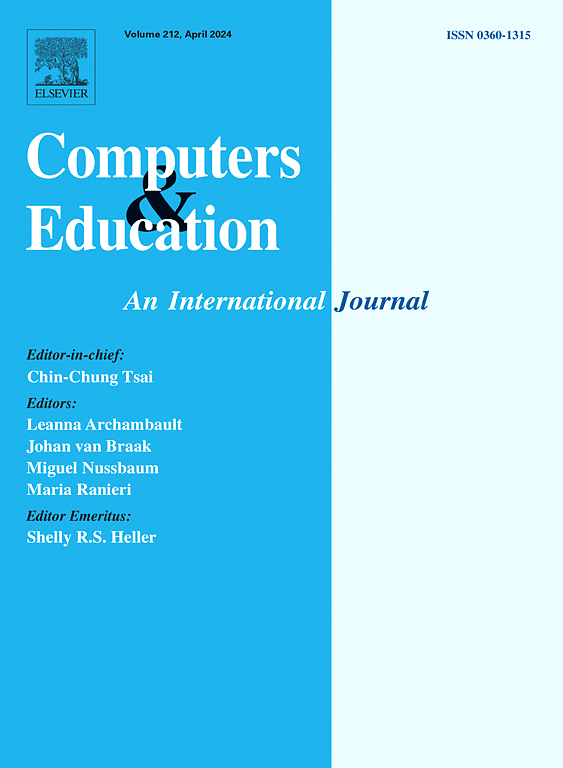数字多文本阅读中学习者何时及如何参与源信息:眼动追踪技术对任务指导和文本可信度的影响
IF 10.5
1区 教育学
Q1 COMPUTER SCIENCE, INTERDISCIPLINARY APPLICATIONS
引用次数: 0
摘要
具有多文本理解的数字阅读在日常生活中至关重要,特别是随着人工智能生成内容的兴起,使得来源评估对在线信息的真实性至关重要,特别是在学术背景下。尽管它很重要,但关于多文本使用中阅读过程的实时证据有限。为了弥补这一差距,我们使用眼动追踪技术来观察任务指令如何影响高可信度和低可信度文本的阅读。文本与源信息之间的过渡,以及读者的关注程度尤其值得关注。61名大学生被随机分为总结组和论证组,分别被要求写总结和论证。两组人都阅读了四篇关于转基因技术的相互矛盾的文章。每篇文章都有高可信度和低可信度的特点,包括三个段落:来源、证据和结论。眼球运动数据的结果显示,两组人都花了更多的时间重读高可信度的文本和证据段落。总结组明显比论证组更多地重读源信息,在源和证据之间进行更多的转换,并且访问文本的次数更多。在论文写作中,与论点组相比,摘要组通过使用更多的源引用和连接词以及参考更多的概念,表现出更好的整合。中介分析发现,重读时间和点击次数的过程数据成功中介了任务指令与多文本整合之间的关系,证实总结组参与深度。这些发现为开发适应性、个性化的数字阅读环境提供了理论贡献和实践意义。本文章由计算机程序翻译,如有差异,请以英文原文为准。
When and how learners engage with source information in digital multiple-text reading: Effects of task instruction and text trustworthiness from eye-tracking technology
Digital reading with multiple-text comprehension is essential in daily life, especially with the rise of AI-generated contents, making source evaluation crucial for authenticity of online information, particularly in academic contexts. Despite its importance, there is limited moment-to-moment evidence on reading processes in multiple-text use. To bridge this gap, we used eye-tracking technology to see how task instructions affect reading multiple texts with high and low trustworthiness. The transitions among texts and source information, as well as how much attention the readers paid are particularly of concern. Sixty-one college students were randomly divided into summary and argument groups, tasked with writing a summary or an argument, respectively. Both groups read four texts presenting conflicting views on genetically modified technology. Each text featured high or low trustworthiness and included three paragraphs: source, evidence, and conclusion. Results of eye-movement data showed both groups spent more time rereading high-trustworthiness texts and evidence paragraphs. The summary group notably reread more on source information, made more transitions between source and evidence, and accessed texts more times than the argument group. In essay writing, the summary group showed better integration by using more source citations and connectives and referring to more concepts, compared to the argument group. Mediation analysis revealed that the process data of rereading time and number of click times successfully mediated the relationship between task instructions and multiple-text integration, confirming that the summary group engaged deeply. These findings offer both theoretical contributions and practical implications for developing adaptive, personalized digital reading environments.
求助全文
通过发布文献求助,成功后即可免费获取论文全文。
去求助
来源期刊

Computers & Education
工程技术-计算机:跨学科应用
CiteScore
27.10
自引率
5.80%
发文量
204
审稿时长
42 days
期刊介绍:
Computers & Education seeks to advance understanding of how digital technology can improve education by publishing high-quality research that expands both theory and practice. The journal welcomes research papers exploring the pedagogical applications of digital technology, with a focus broad enough to appeal to the wider education community.
 求助内容:
求助内容: 应助结果提醒方式:
应助结果提醒方式:


